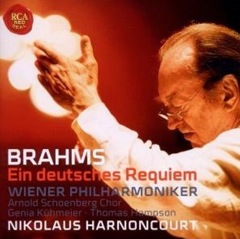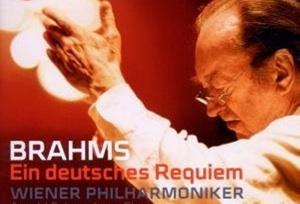
There was a time, maybe two decades ago, when it looked as though historical performance was going to sweep in all of the standard repertoire, as it had swept in most of the first half of the 18th century. Modern-instrument Baroque performances, apart from a few canonical works of Bach, Handel, and Vivaldi, were getting rare; "period" Haydn and Mozart and Beethoven becoming commonplace; and historical performers forging eagerly ahead towards Schumann, Mendelssohn, Wagner, Bruckner, and Brahms.
What's happened since? Well, the expansion, as a period-instrument expansion, just petered out. Very few historical instrumentalists seem much interested in anything past, say, the 1830s. Several of the conductors who led the early-music movement in its 1980s expansionist phase, on the other hand, have repositioned themselves as conductors of modern-instrument ensembles. Roger Norrington and John Eliot Gardiner have long been conducting "modern" orchestras, as has American Bach Soloists founder Jeffrey Thomas.
Listen To The Music
Ein Deutsches Requiem, IV. Wie lieblich sind deine Wohnungen (excerpt)Ein Deutsches Requiem, VII. Selig sind die Toten, die in dem Herren sterben (excerpt)
So has Nikolaus Harnoncourt. A central figure in the period-instrument scene for something like a half century now, Harnoncourt was already conducting the (modern-instrument) Chamber Orchestra of Europe 20 years ago. Since then he's gone far afield from the 17th- and 18th-century music that was long his home. His new recording of Brahms' Ein deutsches Requiem (recorded in 2007, but only just released), with the Vienna Philharmonic and the Arnold Schoenberg Choir, is an often lovely, often puzzling performance — sometimes innocently affectionate, sometimes seeming to be making historical points in a way that does the music no good.
The booklet contains a long and most interesting essay by Benjamin-Gunnar Cohrs on the Deutsches Requiem, providing details about its genesis, performance history, and performance conditions that were new to me. I didn't know, for example, that the first performance of any of it was of the first three movements only; that the next was of six movements; that the fifth movement — the great soprano aria with choir "Ihr habt nun Traurigkeit" (And ye now therefore have sorrow) — was added after that. I didn't know that this was the first of six Brahms works to have composer-authorized metronome marks. And while I knew that Brahms had made a four-hand piano reduction, the droll quotation from a letter to his publisher included here on that subject was another find.
Cohrs devotes a lot of space to performance practice in Brahms' day, and it's natural to wonder how much of what he describes makes it into Harnoncourt's own performance. So far as I can tell, not all that much.
Granted, there's a period instrument here; but it's called "the Vienna Philharmonic," and it sounds pretty much like itself. There are, admittedly, places where Harnoncourt has put his brand of "period" stamp on the performance. There's a bit less string vibrato than usual, for example; the winds and especially the brass seem to be at their most pungent; timpani sticks seem pretty hard; the balances suggest something smaller than the full VPO string section.
And there are a few touches that I imagine the orchestra had to be coaxed into. There's the almost mincing articulation of the sixth-movement fugue "Herr, du bist würdig" (Thou art worthy, O Lord), for one thing. You've just gotten through an elaborate depiction of the Last Judgment, for pity's sake — make it sturdy. The scalloped two-note slurs in the seventh and last, "Selig sind die Toten" (Blessed are the dead), sound a bit as though they'd wandered in from the century prior.
It was the tempos that struck me most, though. Harnoncourt is strikingly leisurely in a lot of places. The fugue at the end of the third movement is a lot slower than what you could call industry standard (though in fact it does line up nicely with the metronome mark). That's a case where I think the modern instinct to hurry through is a good idea. The ear can take only so much music over a pedal tone. "Wie lieblich sind deine Wohnungen" (How lovely are thy tabernacles), the fourth movement, is also unusually slow, as is the Last Trumpet music in the sixth movement.
The flip side of this is that other parts of the piece are taken a good deal more quickly than once was traditional. I pulled out the two old recordings I had on my shelf — Sinopoli's from 1983 and Haitink's from 1980 — and while they were both slower overall than Harnoncourt's, the dramatic difference was in the first and last choruses, "Selig sind, die da Leid tragen" (Blessed are they that mourn) and "Selig sind die Toten": Harnoncourt gets through each of those in two minutes or more less time than either of the older recordings.
Neither movement sounds rushed in the Harnoncourt performance, though. The Arnold Schoenberg Chorus does wondrous work throughout; the first movement feels entirely natural in tempo, the last just a shade unusual, while the unusually slow things ("Wie lieblich" in particular) are sustained with uncommon grace.
(Cohrs' note, by the bye, mentions that a performance of the Deutsches Requiem that follows the metronome marks in the score ought to take between 60 and 65 minutes. For what it's worth, the recordings on period instruments shake out as follows: Roger Norrington, 68 minutes; John Eliot Gardiner, 66; Phillipe Herreweghe, also 66. Harnoncourt's is 72 minutes.)
The soloists are good, but not perfect. Thomas Hampson, the baritone, is a powerful singer, but there are some spots of crudity and clumsiness here and there, and a histrionic note that I find a little off-putting. The soprano in "Ihr habt nun Traurigkeit" is Genia Kühmeier, a name I'd not encountered before. She sustains it very well, and if I found her just a trifle underweight for the part, it's only because I have Haitink's Gundula Janowitz in my ears.
And may I say a word about Sony's booklet? Cohrs' essay is indeed fascinating, but there are — inexcusably — neither photos nor biographies of the vocal soloists. I suppose orchestral and choral rosters are too much to hope for from Sony, but some indication of the size of the ensemble — and a brief note on what Harnoncourt (as opposed to Brahms) actually did performance-practice-wise here — would have been welcome, given the space allotted to those matters in the note. Grrr.

